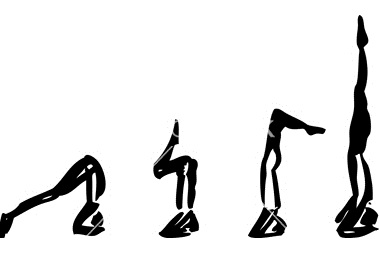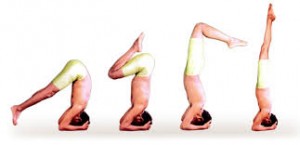Sheershasana or Headstand
Sheersha denotes ‘head’ which is performed to make blood circulation better for head and eyes. This asana is treated as the king of all Asanas. Sheershasana or Headstand is also known as ‘kapaliasana‘. This asana needs huge practice to perform smoothly.
Stages:
- Spread a blanket on the floor and kneel on it. Put your hands on thighs.
- Place your top of the head on the floor and clasped your fingers behind the head to support the head between clasped hands. Rest your forearms and elbows on the floor in a triangle shape to support your whole body.
- Bend your body forward, lift the hips, and straighten your knees as the figure shows. Concentrate on the body balance while doing so.
- Slowly walk the toes towards head, raise the leg slowly one by one. Try to put your whole body weight on the forearms and elbows. Bring your heels closer to buttocks and keep your back straight.
- Finally straighten the legs completely in the direction of the sky while keeping the body balance. Keep your feet, body; head and neck in relax position for seconds. Balance the weight between your arms and elbows.
While releasing from the above position, slowly bend your knees and keeps the toes on the floor while straightening the knees. Keep your knees on the floor and stay in child position for some seconds to get relaxed. Slowly raise your head opening the clasped hands. Sit properly and stand up slowly.
Note:
- Bend in the above position as much as you can but not more than five minutes. Beginners are suggested to give five to fifteen seconds and expand the time to five minutes after practices.
- Perform the exercise with empty stomach only.
- Exercise can be performed twice a day i.e., Morning and evening.
- Do not jump or fling so quickly. Perform each activity slowly and balancing the body.
- Breathe in the normal way, through the nose only, not through the mouth.
- A beginner may take the help of someone while raising the legs upward to balance the body.
- This asana must not be performed in summers too much; it is more helpful for winters.
- If the asana is performed for less time, one may keep eyes open. But if it is to be performed for long time, it is better to keep your eyes closed to enable to meditate.
- Have relaxed at least for five minutes after performing the asana.
- It should not be performed by those who are suffering from ear & throat infection, weak eyes, insomnia. Avoid doing at the time of mensuration, high blood pressure etc.
Benefits:
- Increases blood circulation to head and eyes so strengthen the capacity of the sensory body parts such as head, eyes, ear, throat and nose.
- Improves the memory power and enables to concentrate more.
- It cures asthma, diabetes, headaches, migraines, imbalance etc.
- It exhales the carbon dioxide and other harmful toxins from the lungs.
- It brings the impure blood of lower body part to the heart which functions to make the blood pure and so generates clean blood to the lower parts.


